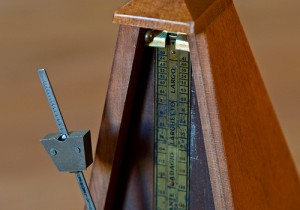Happy Thursday! I hope you are staying warm. Two weeks ago I began my three part series on rhythm, and began by discussing why it’s important to play with proper rhythm and how to work on rhythm in lessons. This week I’m going to expand on what I already discussed, but will focus on metronomes–explaining the difference between the various kinds and how to select the best one for you to use. If you missed my post from a couple of weeks ago, you can check it out here.
First of all, if you don’t know what a metronome is, it’s a fantastic tool that helps musicians play with a steady beat and keep their rhythms correct and in time. It creates an audible clicking steady beat that you can make faster or slower depending on your piece.
When you play with a metronome, you’ll set it to a certain number such as a quarter note= 60 bpm. The bpm is the number of times the metronome will click during one minute, so at 60, it will click once/ second.
The types of metronomes are as follows:
- Metronome App
You can download a free app in the Apple store or Android market to use on your phone or tablet. I personally use the one called “Metronome” on my i-phone. The phone app is great because it’s free, and it’s with me everywhere I go. It’s a basic metronome, but does allow you to change the time signature, so that the emphasis falls on beat 1 depending on how many beats are in the measure.
Generally when I notice that students first need to use a metronome, I’ll use this app with them in lessons. I suggest that they download the app on their or their parents’ device for in-home practice.
- Electronic Metronome
This is a metronome that you purchase for about $30+ that runs on batteries. You turn a dial to change the speed of the clicks. Often a light will flash in sync with the beat that clicks. Some of these metronomes have a more electronic sounding click, where others have a more traditional sounding click. I usually use this one with my students.
- Mechanical Metronome
This metronome has a pendulum that clicks left and right creating the beat. It does not run on batteries. These metronomes are more expensive and more fragile. They work well for students who prefer a more traditional “clicking” sound similar to a clock and like to see the pendulum click from side to side. After using the metronome for some time, you’ll need to wind the knob on the side of the metronome or the metronome will begin to click more slowly. My favorite mechanical metronome is this one.
As I said above, I pretty much always have students start by using the free app. After it becomes apparent that they’ll need to practice more often with the metronome, I’ll let their parents know that I’d like to pick up a metronome for them to use in lessons and practicing. Deciding between the electronic metronome or the mechanical metronome is really a personal preference.
Get an electronic metronome if:
- you don’t want to spend a ton of money
- you are prone to dropping and breaking fragile objects
- you don’t mind an electronic sound
- you want something that’s easy to bring with you
Get a mechanical metronome if:
- your budget allows you to spend in the ballpark of $50+ for a metronome
- you learn best visually– seeing the clicking pendulum really helps you
- you are careful and gentle with fragile things
Personally, I have both! I keep the electronic metronome in my oboe case, so it’s with me anytime I’m practicing or rehearsing with my oboe. I keep my Taktell Piccolo mechanical metronome on my piano. I love seeing the side to side clicking and am very careful to not break it.
Now that you know what a metronome is and the various types, you’ll need to know how to use one. I’ll be sharing that in the final part of this three part rhythm series coming up in two weeks. Stay tuned!
Now I want to hear from you! Leave a comment below and tell me what your favorite type of metronome is and why. If you haven’t already, subscribe to the newsletter, and “like us” on Facebook. Have a musically filled day!
Sincerely,
Cassie

{ 0 comments… add one now }